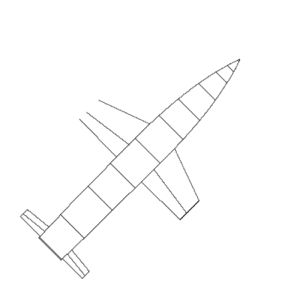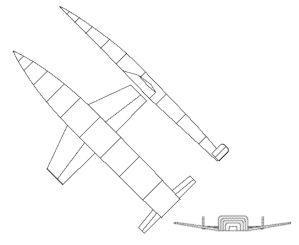
Home - Search - Browse - Alphabetic Index: 0- 1- 2- 3- 4- 5- 6- 7- 8- 9
A- B- C- D- E- F- G- H- I- J- K- L- M- N- O- P- Q- R- S- T- U- V- W- X- Y- Z
Saenger Antipodal Bomber
 Saenger Bomber Saenger Antipodal bomber designs Credit: © Mark Wade |
AKA: Saenger. Status: Study 1943. Payload: 5,000 kg (11,000 lb). Thrust: 6,000.00 kN (1,348,800 lbf). Gross mass: 133,773 kg (294,918 lb). Height: 34.00 m (111.00 ft). Diameter: 2.32 m (7.61 ft).
Eugen Saenger conceived of a winged spaceplane while a doctoral candidate at the Vienna Polytechnic Institute. His 1933 Silverbird concept was for a Mach 10 glider that would cruise at 160 km altitude. The aircraft was to have a spindle-shaped fuselage and low aspect ratio wedge wings. Saenger published Techniques of Rocket Flight' privately in late 1933. By 1934 he had refined the design to a hypersonic boost-glide vehicle. It would have a hypersonic L/D ratio of 5.1, reach a top speed of Mach 13 at burnout of its rocket motor, and then enter a 5,000 km long glide, reaching a stable Mach 3.3 cruise at 50 km altitude. By the end of the 1930's Saenger had refined the Silverbird aerodynamics to a flat-bottomed, half-cone slender body, with a hypersonic L/D of 6.4 and a subsonic L/D of 7.5. The final refinement to the design was his 1944 report Concerning Rocket Propulsion for Long-Range Bombers, which featured a spaceplane 28 m long with a 15 m wingspan and 100 tone take-off mass. The glider would reach a top speed of 21,800 kph and have a range of 23,400 km.
Flyaway Unit Cost 1985$: 16.000 million. Maximum range: 25,000 km (15,000 mi).
Stage Data - Saenger
- Stage 0. 1 x Sanger Sled. Gross Mass: 34,000 kg (74,000 lb). Empty Mass: 6,800 kg (14,900 lb). Thrust (vac): 6,860.000 kN (1,542,180 lbf). Isp: 245 sec. Burn time: 10 sec. Isp(sl): 210 sec. Diameter: 2.32 m (7.61 ft). Span: 2.32 m (7.61 ft). Length: 14.02 m (45.99 ft). Propellants: Lox/Alcohol. No Engines: 6. Engine: Sanger-Bredt Sled. Status: Study 1943.
- Stage 1. 1 x Sanger-Bredt. Gross Mass: 99,773 kg (219,961 lb). Empty Mass: 19,955 kg (43,993 lb). Thrust (vac): 1,428.800 kN (321,207 lbf). Isp: 306 sec. Burn time: 168 sec. Isp(sl): 210 sec. Diameter: 2.32 m (7.61 ft). Span: 15.00 m (49.00 ft). Length: 28.00 m (91.00 ft). Propellants: Lox/Kerosene. No Engines: 1. Engine: Sanger-Bredt. Status: Study 1943.
Family: Boost-glide, Sled-Launched, Winged. People: Saenger. Country: Germany. Engines: RDKS-100, Sanger-Bredt Sled. Spacecraft: Dynasoar. Stages: Sanger Sled, Sanger-Bredt. Bibliography: 17, 47.
 | Saenger Silverbird Credit: © Mark Wade |
 | Saenger Silverbird Saenger Silverbird 3 view Credit: © Mark Wade |
Late 1933 - . LV Family: German Rocketplanes. Launch Vehicle: Saenger Antipodal Bomber.
- Saenger begins rocket engine tests. - . Nation: Germany. Related Persons: Saenger. Eugen Saenger begins a series of rocket engine tests in Vienna. He methodically explores various propellant combinations and additives through the end of 1934..
1933 December 15 - . LV Family: German Rocketplanes. Launch Vehicle: Saenger Antipodal Bomber.
- Rakatenflugtechnik published. - . Nation: Germany. Spacecraft: Dynasoar. Eugen Sänger of Germany published his classic Rakatenflugtechnic, which dealt with rocket motor design and high-speed flight in the atmosphere..
August 1944 - . LV Family: German Rocketplanes. Launch Vehicle: Saenger Antipodal Bomber.
- Saenger antipodal bomber - .
Nation: Germany.
Related Persons: Saenger.
Spacecraft: Dynasoar.
Eugen Saenger and Irene Bredt issue their final 400-page report on the Saenger antipodal bomber - a rocket boosted skip-glide spaceplane with global range. Only 100 numbered copies are printed, and distributed to German political and scientific leaders. The futuristic scheme would have taken many years to develop and was of only academic interest to the German government. But copies of the report fell into the hands of the Americans and Russians after the war, spawning major development projects in the fifties.
Back to top of page
Home - Search - Browse - Alphabetic Index: 0- 1- 2- 3- 4- 5- 6- 7- 8- 9
A- B- C- D- E- F- G- H- I- J- K- L- M- N- O- P- Q- R- S- T- U- V- W- X- Y- Z
© 1997-2019 Mark Wade - Contact
© / Conditions for Use